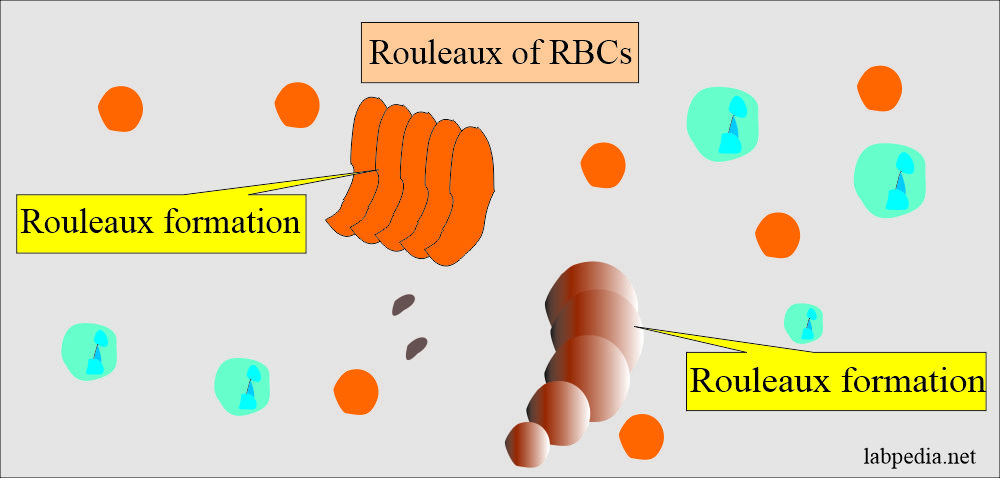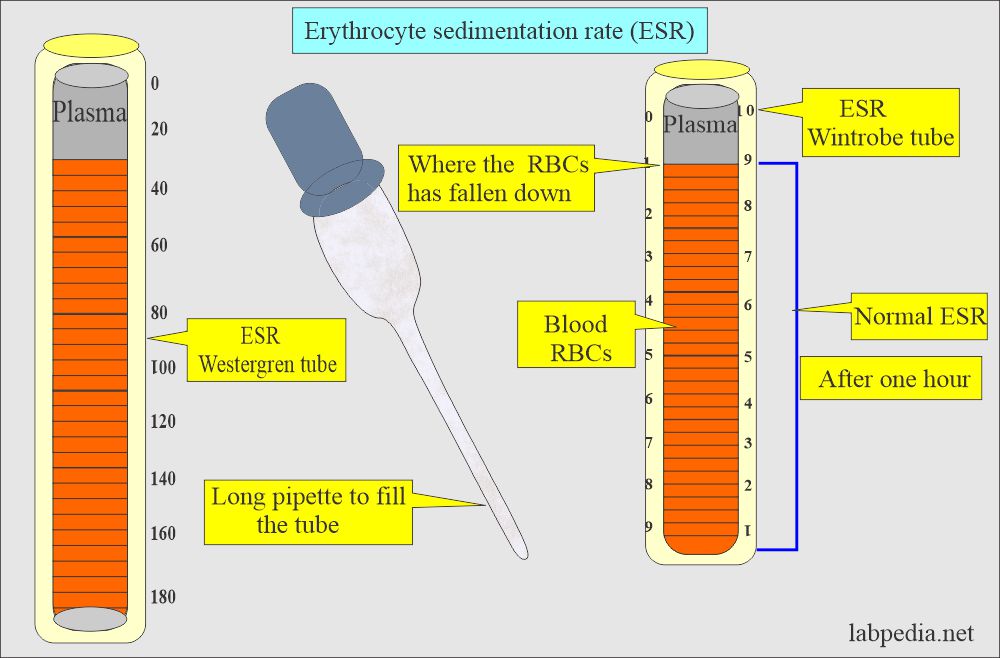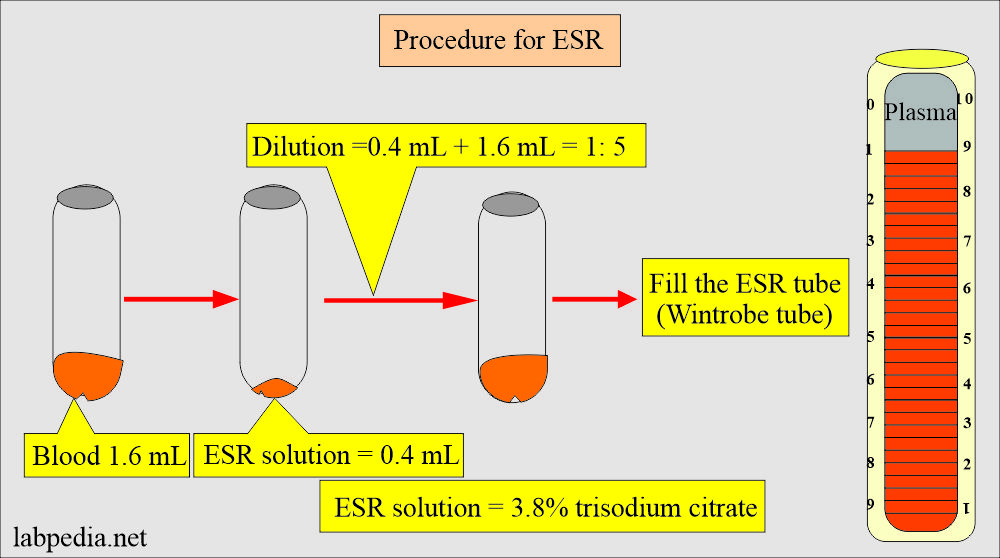Erythrocyte Sedimentation Rate (ESR), Solution and Procedure
Erythrocyte Sedimentation Rate (ESR)
What sample for Erythrocyte Sedimentation Rate (ESR) is needed?
- Blood in EDTA or oxalate can be used.
What is the principle of Erythrocyte Sedimentation Rate (ESR)?
- ESR test is based on the principle of sedimentation.
- When the blood in an anticoagulant is left, undisturbed RBCs will settle in the container, or the Wintrobe tube marked 0 to 100 mm.
How will you define the Erythrocyte Sedimentation Rate (ESR)?
- This is the speed of sedimentation of red blood cells in plasma for one hour.
- Erythrocyte sedimentation rate (ESR), also known as sed rate, is a nonspecific test.
- ESR indicates acute and chronic inflammatory processes.
What are the indications for the Erythrocyte Sedimentation Rate (ESR)?
- This is a nonspecific test but, when raised, has great significance.
- This is the best test to diagnose occult disease.
- Diagnose and monitor temporal arteritis.
- Diagnose and monitor the Polymyalgia rheumatica.
- Monitoring Hodgkin’s disease.
- Advanced Malignancies.
- ESR is raised in myocardial infarction, while it is normal in angina.
What factors will influence the Erythrocyte Sedimentation Rate (ESR)?
- Plasma protein:
- RBCs suspended in the plasma form aggregation in normal blood. So, if there are more proteins, the sedimentation rate is slow.
- A rouleaux formation will give a false value and be seen in increased proteins or globulins. So, acute phase protein affects the ESR.
- Number of RBCs:
- ESR depends upon the number of RBCs; with an increase in anemia, the number of RBCs settles down rapidly.
- In the case of polycythemia, RBCs settle slowly, and ESR is low.
- The shape of RBCs:
- The shape of RBCs affects the ESR, like in sickle cell anemia; ESR may be low or zero.
- Size of the RBCs:
- Macrocyte cells settle more rapidly than microcytes because of their large size.
What are the technical factors affecting ESR, giving false increased value?
False increased ESR is seen in:
- Test when reading after one hour. or before one hour.
- When there is improper dilution with the anticoagulant.
- When the tube is not vertical and is tilted to one side. Even a 3 ° angle can increase the ESR by 30%.
- If there is a vibration of the tube during the test.
- If blood is not mixed properly or there are micro-clots.
- The test is done at room temperature >25 °C. Keep the temperature constant between 20 °C to 25 °C.
- Don’t operate the centrifuge machine on the same table.
- Don’t move the ESR rack during the process.
- Use the fresh blood with EDTA-anticoagulant whole blood.
- Fill the ESR tube to the top and avoid any bubbles in it.
What are the technical factors affecting ESR and giving false lower values?
False decreased ESR values are seen in the following:
- When the test is read for less or more than one hour.
- Improper mixing of the blood.
- Improper dilution of the blood.
- If the blood temperature is low.
- If there are air bubbles in the tube.
- If the room temperature is <20 °C.
How will you perform the Erythrocyte Sedimentation Rate (ESR)?
Reagent required:
- Analytical balance.
- Trisodium citrate (analytical grade).
- Distal water.
How will you prepare an Erythrocyte Sedimentation Rate (ESR) solution?
- Weigh 3.8 grams of Trisodium citrate/100 mL of water.
- Suppose you are preparing 500 mL of ESR solution.
- Take 19 grams of Trisodium citrate (3.8 x 5 = 19).
- Dissolve in 500 mL of distal water.
- Mix thoroughly.
How will you perform the Erythrocyte Sedimentation Rate (ESR) by the Wintrobe method?
- ESR should be done within 2 hours of the collection of the blood.
- Blood can be kept at 4°C for 6 hours. Now, bring the blood to room temperature.
- Take 0.4 mL of ESR solution + 1.6 mL of oxalate blood or blood in EDTA.
- Fill the Wintrobe ESR tube. (mix the blood thoroughly before filling the tube).
- Mount in the ESR stand.
- Start the clock for one hour.
- Record the result after one hour.
- That is the ratio of settled cells and above clear plasma.
- The temperature should be kept between 20 to 25 °C.
Procedure for Erythrocyte Sedimentation Rate (ESR) by Westergren method:
- The pipette is graduated from 0 to 200 mm, and the holding rack is used.
- This method is more sensitive than the Wintrobe method.
- In this case, blood is diluted with 3.8% sodium citrate.
What is the Zeta sedimentation rate (ZSR)?
- It is not affected by anemia or globulin proteins.
- The normal range is the same for males and females. It uses a small amount of blood.
- This is good for children because of the small blood volume.
- It is calculated from the hematocrit and zitacrit and reported as a percentage.
- Procedure for Zitacrit:
- A small-bore capillary tube is filled with blood from the finger prick.
- This capillary is spun in the special centrifuge called the Zetafuge (Coulter diagnostic).
- This tube is read on the special reader to get the zitacrit value.
- Calculation as %: Zitacrit (% of sedimented RBCs)/hematocrit = Result expressed as % (percentage).
- Reference values of ZSR for all ages:
Reference range % value Normal 40% to 51% Borderline 51% to 54% Raised level ≥55%
What is the difference between Automated Mini-Ves and one-hour ESR?
- Automatic Mini-Ves ESR measures in 20 minutes instead of one hour.
- This 20-minute ESR reading correlates to the 1-hour Westergren method.
- 1mL of sample is drawn up into a 0.109 mol/L sodium citrate solution.
- It is placed in the Mini-VES machine.
- This instrument records the reading via its optical assembly.
- The second reading is recorded after 20 minutes to give the ESR value.
What is Normal ESR?
Source 1
| Age | mm/h | mm/h |
| Child | 0 to 10 | |
| Adult | Male | Female |
| <50 years | 0 to 15 | 0 to 20 |
| >50 years | 0 to 20 | 0 to 30 |
Source 4
| Gender | Wintrobe mm/Hour | Westergren mm/hour |
| Men |
|
|
| Women |
|
|
| Children |
|
What are the causes of increased Erythrocyte Sedimentation Rate (ESR)?
- Severe Anemia.
- Macrocytosis.
- Pregnancy.
- Increased plasma globulins.
- Increased plasma fibrinogen.
- Multiple myelomas.
- Acute and chronic inflammatory conditions.
- Autoimmune inflammatory diseases.
- Chronic renal failure.
- Cancers (malignant tumors).
- Acute myocardial infarction.
What are the causes of decreased Erythrocyte Sedimentation Rate (ESR)?
- In the case of Sickle cell anemia.
- Microcytosis.
- Spherocytosis.
- Polycythemia.
- Increased plasma viscosity.
Differential diagnosis of the Erythrocyte sedimentation rate (ESR):
| Clinical diseases | ESR is raised | ESR not raised |
|
|
|
|
|
|
|
|
|
|
|
|
|
|
|
|
|
|
How will you summarize the erythrocyte sedimentation rate (ESR)?
- This is a simple and nonspecific test to find the presence of the inflammatory process.
- It helps monitor conditions like anemia, renal diseases, acute myocardial infarction, and collagen diseases.
- It does not help to diagnose the disease. A normal ESR does not rule out malignancy and other serious diseases.
- It only helps to see the progress of the disease.
- ESR is a good indicator of hidden diseases like tuberculosis, SLE, and subacute bacterial endocarditis.
- ESR will differentiate between:
- AMI vs angina pectoris.
- Acute appendicitis vs. ruptured ectopic pregnancy.
- Rheumatoid arthritis vs. osteoarthritis.
- Acute vs. silent gout.
- Iron deficiency anemia vs. anemia of acute or chronic diseases.
- NOTE: Please see more details on ESR in CBC.
Question 1: What is the value of ESR in myocardial diseases?
Question 2: What is the value of ESR in RA and osteoarthritis?





i like it, note
Thanks.
I agree with you
Thanks.
Thanks for your effort
Thanks.
Thanks for this
Welcome.
Thanks for again
Tq sir for this information
Thanks for this
You are welcome.
Thanks for excellent write-up, its highly informative.
Thanks for the remarks.